All the aquarium hobbyists who are searching for a guide to install a complete co2 system for aquarium, you have landed in the right place!
As newcomers step into the realm of aquariums, they typically begin with low-maintenance plants that don’t demand much light or intricate fertilizer. Nevertheless, as you get more into this, you may come across plants that require a higher level of care. This is where the aquarium co2 kit becomes necessary!
Aquarists have developed a DIY aquarium co2 kit and Aquarium Co-Op has put together an accessible guide for beginners. Choosing between Low-Tech and Hi-Tech setups is vital since introducing a co2 reactor for aquarium and co2 diffuser can yield remarkable outcomes.
So let’s get started, to help you learn what size co2 tank for aquarium is needed and how to put together all the equipment for complete co2 system for aquarium!
Why an Aquarium co2 system is a Must?
Carbon dioxide plays a crucial role in maintaining the health and growth of aquatic plants in a planted aquarium. Unlike plants in natural environments that receive CO2 from sources such as substrate and decaying matter, enclosed aquariums lack this natural supply.
In dim light, additional CO2 may not be required; however, for medium to high lighting setups, injecting CO2 into the water column is necessary to meet the increased demands of thriving plants effectively. Failing to provide adequate amounts can result in stunted growth or even encourage unwanted algae formation.
Therefore, to ensure an abundant and healthy aquarium environment, the first step is understanding what size CO2 tank for aquarium and utilizing a reliable co2 reactor for aquarium along with aquarium co2 kit are following vital steps towards achieving flourishing aquatic plant life.
Things You Need to Install Complete co2 System for Aquarium
- Aquarium Co-Op co2 regulator
- CO2 cylinder tank
- Co2 tubing or Airline tubing
- Check valve
- Co2 diffuser
- Water or Mineral Oil
- Electrical Outlet Timer
- Scissors
Understanding Equipment
- Co-Op Regulator: A regulator is an essential device in an aquarium co2 kit that carefully controls the gas flow from a CO2 cylinder into the aquarium water. There are two main types available – single-stage and two-stage regulators. A single-stage regulator reduces pressure in one step, whereas a two-stage regulator accomplishes this in two steps for better accuracy and consistency of CO2 supply.
In comparison to DIY systems that often lack uniformity and require frequent upkeep, opt for pressurized CO2 systems coupled with regulators and cylinders instead. These set-ups guarantee consistent delivery of CO2 to your aquarium while supporting healthier growth for your plants.
Moreover, the Aquarium Co-Op regulator in the aquarium co2 kit cannot be used with CO2 paintball cylinders, as it is specifically designed to be compatible with standard tanks that have a CGA320 thread. - Aquarium Co-Op airline tubing: The airline tubing in the aquarium co2 kit, which is made of flexible black PVC, proves to be effective in preventing any CO2 loss. This standard airline tubing option works just as well as the more expensive and less accessible specialized CO2 tubing options.
Not only does it offer flexibility and cost savings, but it also ensures that the check valves stop water from escaping the aquarium and causing the regulator to malfunction. There is a built-in check valve on the Aquarium Co-Op regulator, and a stainless steel version is also offered for greater durability in a complete co2 system for aquarium. - CO2 Diffuser: Any aquarium CO2 diffuser that can run at 40 to 50 psi is appropriate. Follow the manufacturer’s instructions on the aquarium co2 kit when cleaning clogged diffusers to get rid of algae buildup. You can also use vinegar, diluted bleach, or other suitable cleaning agents.
- Mineral Oil/ Water: Use mineral oil for a long-lasting solution or tap water to monitor the CO2 rate in the bubble counter.
Setting Up Aquarium CO2 System
- Step 1: Attach the Regulator
The first step in the aquarium co2 system is to fasten the regulator tightly to the CO2 bottle using a spanner. Make sure it is tightly attached to prevent any gas leaks.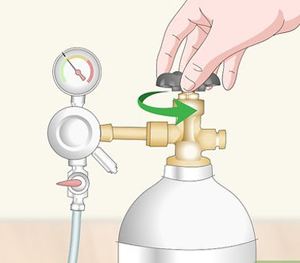
- Step 2: Assemble Components
Use the above image or you can watch a YouTube video, and assemble all other components accordingly. Ensure that everything is connected correctly.
(note: attach schematic diagram)
- Step 3: Slightly Open Valve
Before releasing the gas from the bottle, slightly open the needle valve on the regulator. This will help protect the solenoid from damage when you open the main valve on the CO2 bottle.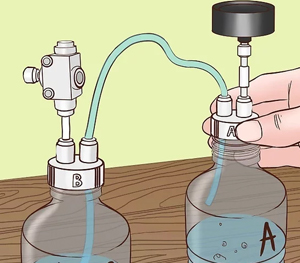
- Step 4: Turn On the Main Valve
Start by turning on the main valve situated at the CO2 bottle to release the gas. If the bottle is completely filled, you should see a reading of around 800-1000psi on the left gauge of your regulator.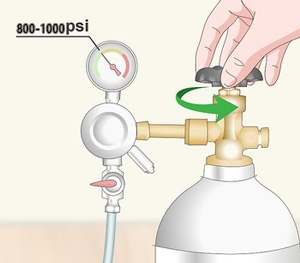
- Step 5: Adjust the CO2 Flow Rate
Move on to adjusting the rate of CO2 flow by gradually turning half a turn on the needle valve. Pay attention to bubbles in your bubble counter. For smaller aquariums, aim for approximately 1-2 bubbles per second while larger tanks might require more.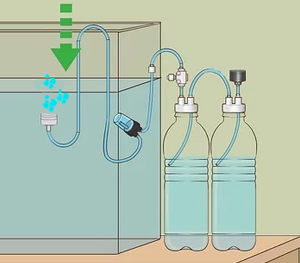
- Step 6: Keep an Eye on CO2 Levels
As time passes, it’s essential to keep an eye on the aquarium co2 system specifically at regular intervals (over a few hours) determining and maintaining adequate levels of CO2 through the usage of a drop checker. Make necessary adjustments accordingly until noticing that the fluid inside the drop checker has turned green.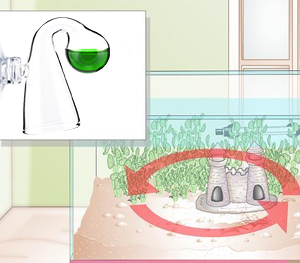
- Step 7: Set Timer for Solenoid Valve
Now, the last step of the complete co2 system for aquarium is to adjust the Timer for the Solenoid Valve. To regulate the CO2 supply during nighttime, make use of an electric plug timer. This convenient device will automatically switch off the CO2 flow when it’s dark. Whenever you turn on this timer, it triggers the opening of the solenoid valve to allow CO2 into your aquarium.
By following these straightforward instructions, setting up a reliable and efficient complete co2 system for aquarium becomes super easy.
Remember to also conduct regular inspections for potential leaks before utilizing the aquarium co2 kit and continually monitor your carbon dioxide levels to ensure optimal conditions.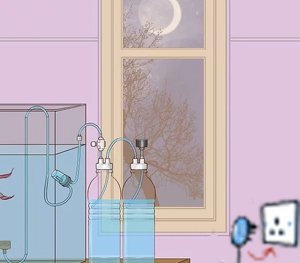
How Much CO2 Should You Inject via co2 Reactor for Aquarium?
Finding the right amount of CO2 dosage when setting up a complete co2 system for aquarium is crucial! Experts suggest starting with a gentle rate, releasing around 1 bubble per second to ensure the safety of fish.
However, it’s important to remember that CO2 requirements can vary depending on factors such as plant and fish levels in the tank, making bubble rates an imperfect measure. Rather than aiming for an exact 30 ppm level of CO2, we rely on observing plant behavior as per the guide that comes with the aquarium co2 kit.
Try to make adjustments to the CO2 dose until we see plants exhibiting a “pearling” effect – where they release oxygen bubbles during photosynthesis. It’s essential not to rush the aquarium co2 system process and be patient instead.
We recommend waiting at least three days between each adjustment of the complete co2 system for aquarium because plants need time to respond adequately to any changes made.
How Long Should You Run CO2 in Your Aquarium?
To achieve the best results of a complete co2 system for aquarium, it is recommended to initiate CO2 injection using an automatic timer at least 1-2 hours before turning on the tank lights.
During the initial light exposure, plants utilize CO2 most effectively. If your light cycle lasts for 6 hours or less, you can either turn off the CO2 injection an hour before the lights off or let it run throughout the entire lighting period.
Typically, for an aquarium co2 system, a combination of 8-hour light and CO2 duration tends to work well; however, individuals who are new to this may opt for a shorter 6-hour light cycle to reduce potential issues with algae growth.
According to the guide of the aquarium co2 kit, in stable tanks where conditions permit, extending the duration of light up to more than 10 hours should not pose any problems.
Is a co2 Reactor for Aquarium Better than CO2 Diffuser?
Both methods, the co2 reactor for aquarium and the CO2 diffuser offer their own unique advantages for dissolving carbon dioxide in water.
The main distinction lies in their efficiency and ease of aquarium co2 system. A co2 reactor for aquarium is highly efficient when it comes to dissolving CO2 due to its design. However, using a co2 reactor for aquarium requires an additional pump or canister filter to function properly.
This extra equipment may be necessary but also increases complexity. Conversely, a CO2 diffuser provides a easier setup as it can be directly attached to your previous aquarium co2 system without any extra effort. Although it might not dissolve CO efficiently compared to a co2 reactor for aquarium, this convenience makes up for it.
Ultimately, choosing between these two- diffuser and co2 reactor for aquarium depends on factors such as your setup, aquarium co2 kit, and preferences.
What Size CO2 Tank for Aquarium Should You Use?
If you have a planted aquarium with an aquarium co2 kit and inject significant amounts of CO2, it’s best to use larger CO2 cylinders. This way, you won’t have to refill them as frequently.
However, if you’re an average aquarium enthusiast, a 2.5-5 lb. cylinder is suitable for tanks up to 20 gallons in size while a 5 lb. cylinder works well for tanks between 25-40 gallons in size. For larger tanks than 40, you have to use bigger cylinders to set up the aquarium co2 system.
Pro Tips
- It is recommended to stop the CO2 supply one hour before turning off the lights. This allows enough time for plants to still receive an adequate amount of CO2 during that last hour.
- Every aquarium setup and tank can vary, so it’s important to experiment with different bubble counts and timings for injecting CO2 accordingly.
- Gradually increase your CO2 levels to reach optimal conditions for both fish and plants without causing any harm specifically to your fish inhabitants.
- Before introducing any fish into your aquarium, test out a complete co2 system for aquarium via an aquarium co2 kit until you find a suitable balance that works best with your specific setup.
Wrap Up
By adhering to our guide of complete co2 system for aquarium and taking a proactive approach to keeping your aquarium co2 system, you can produce an impressive and lively planted aquarium.
So, best of luck with your fishkeeping passion, and enjoy the beauty of your flourishing aquatic tank by installing an aquarium co2 system using an aquarium co2 kit!



